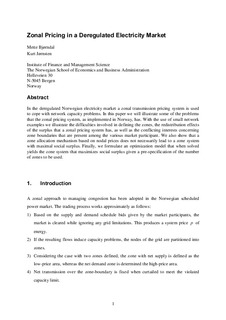| dc.contributor.author | Bjørndal, Mette | |
| dc.contributor.author | Jörnsten, Kurt | |
| dc.date.accessioned | 2006-07-16T17:34:44Z | |
| dc.date.available | 2006-07-16T17:34:44Z | |
| dc.date.issued | 1999 | |
| dc.identifier.issn | 1500-4066 | |
| dc.identifier.uri | http://hdl.handle.net/11250/163921 | |
| dc.description.abstract | In the deregulated Norwegian electricity market a zonal transmission pricing system is used to cope with network capacity problems. In this paper we will illustrate some of the problems that the zonal pricing system, as implemented in Norway, has. With the use of small network examples we illustrate the difficulties involved in defining the zones, the redistribution effects of the surplus that a zonal pricing system has, as well as the conflicting interests concerning zone boundaries that are present among the various market participant. We also show that a zone allocation mechanism based on nodal prices does not necessarily lead to a zone system with maximal social surplus. Finally, we formulate an optimization model that when solved yields the zone system that maximizes social surplus given a pre-specification of the number of zones to be used. | en |
| dc.format.extent | 237089 bytes | |
| dc.format.mimetype | application/pdf | |
| dc.language.iso | eng | en |
| dc.publisher | Norwegian School of Economics and Business Administration. Department of Finance and Management Science | en |
| dc.relation.ispartofseries | Discussion paper | en |
| dc.relation.ispartofseries | 1999:11 | en |
| dc.title | Zonal pricing in a deregulated electricity market | en |
| dc.type | Working paper | en |
